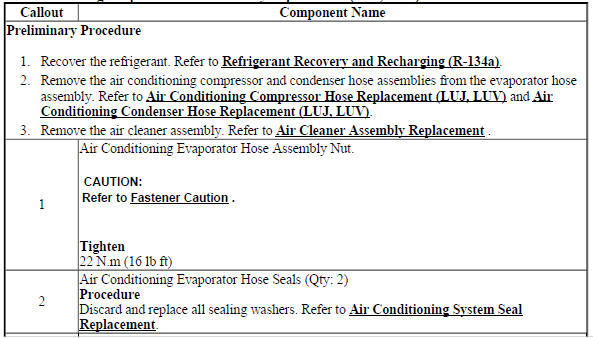Chevrolet Trax: Air conditioning evaporator hose assembly replacement (LUJ, LUV)
.gif)
Fig. 30: Air Conditioning Evaporator Hose Assembly
Air Conditioning Evaporator Hose Assembly Replacement (LUJ, LUV)


AIR CONDITIONING EVAPORATOR HOSE ASSEMBLY REPLACEMENT (2H0)
.gif)
Fig. 31: Air Conditioning Evaporator Hose Assembly (2H0)
Air Conditioning Evaporator Hose Assembly Replacement (2H0)


AIR CONDITIONING REFRIGERANT SERVICE VALVE CORE REPLACEMENT
Special Tools
- GE 50078 Electronic Leak Detector
- GE 46246 Valve Core Tool
For equivalent regional tools. Refer to Special Tools.
Removal Procedure
.gif)
Fig. 32: Valve Core
- Recover the refrigerant from the A/C system. Refer to Refrigerant Recovery and Recharging (R-134a).
- Using the GE 46246 Valve Core Tool , remove the valve core (1) from the service port.
Installation Procedure
.gif)
Fig. 33: Valve Core
CAUTION: Refer to Fastener Caution .
- Install the valve core (1) to the service port.
- Using the GE 46246 Valve Core Tool , tighten the valve core.
- Evacuate and recharge the A/C system. Refer to Refrigerant Recovery and Recharging (R-134a).
- Leak test the fittings of the component using GE 50078 Electronic Leak Detector.
AIR CONDITIONING REFRIGERANT DESICCANT REPLACEMENT (LUJ, LUV)
.gif)
Fig. 34: Air Conditioning Refrigerant Desiccant
Air Conditioning Refrigerant Desiccant Replacement (LUJ, LUV)

AIR CONDITIONING REFRIGERANT DESICCANT REPLACEMENT (2H0)
.gif)
Fig. 35: Air Conditioning Refrigerant Desiccant (2H0)
Air Conditioning Refrigerant Desiccant Replacement (2H0)

AIR CONDITIONING EVAPORATOR THERMAL EXPANSION VALVE REPLACEMENT (LUJ, LUV)
.gif)
Fig. 36: Air Conditioning Evaporator Thermal Expansion Valve
Air Conditioning Evaporator Thermal Expansion Valve Replacement (LUJ, LUV)

AIR CONDITIONING EVAPORATOR THERMAL EXPANSION VALVE REPLACEMENT (2H0)
.gif)
Fig. 37: Air Conditioning Evaporator Thermal Expansion Valve (2H0)
Air Conditioning Evaporator Thermal Expansion Valve Replacement (2H0)
.jpg)


